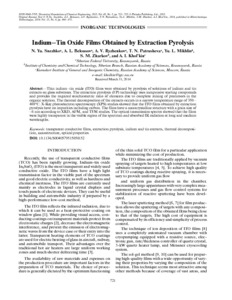Показать сокращенную информацию
Indium–tin oxide films obtained by extraction pyrolysis
| Автор | Snezhko, N. Yu. | |
| Автор | Belousov, A. L. | |
| Автор | Ryzhenkov, A. V. | |
| Автор | Patrusheva, T. N. | |
| Автор | Mikhlin, Yu. L. | |
| Автор | Zharkov, S. M. | |
| Автор | Khol’Kin, A. I. | |
| Дата внесения | 2017-06-16T10:32:01Z | |
| Дата, когда ресурс стал доступен | 2017-06-16T10:32:01Z | |
| Дата публикации | 2015-11 | |
| Библиографическое описание | Snezhko, N. Yu. Indium–tin oxide films obtained by extraction pyrolysis [Текст] / N. Yu. Snezhko, A. L. Belousov, A. V. Ryzhenkov, T. N. Patrusheva, Yu. L. Mikhlin, S. M. Zharkov, A. I. Khol’Kin // Theoretical Foundations of Chemical Engineering. — 2015. — Т. 49 (№ 5). — С. 721-725 | |
| ISSN | 00405795 | |
| URI (для ссылок/цитирований) | https://elib.sfu-kras.ru/handle/2311/33246 | |
| Описание | Текст статьи не публикуется в открытом доступе в соответствии с политикой журнала. | |
| Аннотация | Thin indium–tin oxide (ITO) films were obtained by pyrolysis of solutions of indium and tin extracts on glass substrates. The extraction pyrolysis (EP) technology uses inexpensive starting compounds and provides the required stoichiometric ratio of elements due to complete mixing of precursors in the organic solution. The thermal decomposition of the extracts occurs in a narrow temperature range of 350– 400°C. X Ray photoelectron spectroscopy (XPS) studies showed that the ITO films obtained by extraction pyrolysis have no impurities including carbon. The films have a nanocrystalline structure with a grain size of ~6 nm according to XRD, AFM, and TEM studies. The optical transmission spectra showed that the films were highly transparent in the visible region of the spectrum and absorbed IR radiation at long and medium wavelengths. | |
| Ссылка на другой сайт | http://link.springer.com/article/10.1134/S0040579515050152 | |
| Тема | transparent conductive films | |
| Тема | extraction pyrolysis | |
| Тема | indium and tin extracts | |
| Тема | thermal decomposi | |
| Тема | tion | |
| Тема | nanostructure | |
| Тема | optical properties | |
| Название | Indium–tin oxide films obtained by extraction pyrolysis | |
| Тип | Journal Article | |
| Тип | Published Journal Article | |
| Страницы | 721-725 | |
| ГРНТИ | 44.01.05 | |
| Дата обновления | 2017-06-16T10:32:01Z | |
| Институт | Институт инженерной физики и радиоэлектроники | |
| Подразделение | Кафедра приборостроения и наноэлектроники | |
| Журнал | Theoretical Foundations of Chemical Engineering | |
| Квартиль журнала в Scopus | Q3 | |
| Квартиль журнала в Web of Science | Q4 |

